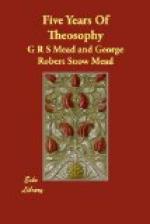-------- * According to the Buddhists, in Akasa lies that eternal, potential energy whose function it is to evolve all visible things out of itself.—Ed. Theos.
** It was never so considered, as we have shown it. But as the “Fragments” are written in English, a language lacking such an abundance of metaphysical terms to express ever minute change of form, substance and state as are found in the Sanskrit, it was deemed useless to confuse the Western reader, untrained in the methods of Eastern expression, more than is necessary, with a too nice distinctions of proper technical terms. As “Prakriti in its primary state is Akasa,” and Sakti “is an attribute akasa,” it becomes evident that for the uninitiated it is all one. Indeed, to speak of the “union of Brahmam and Prakriti” instead of “Brahmam and Sakti” is no worse than for a theist to write that “That man has come into existence by the combination of spirit and matter,” whereas, his word, framed in an orthodox shape, ought to read “man is a living soul was created by the power (or breath) of God over matter.”
*** That is to say, the Aryan Akasa is another word for Buddhist space (in its metaphysical meaning).—Ed. Theos. ---------
In Mantrasastra the letter Ha represents Akasa, and you will find that this syllable enters into most of the sacred formula intended to be used in producing phenomenal results. But by itself it does not represent any Sakti. You may, if you please, call Sakti an attribute of Akasa.
I do not think that, as regards the nature of this principle, there can in reality exist any difference of opinion between the Buddhist and Brahmanical philosophers.
Buddhist and Brahmanical initiates know very well that mysterious circular mirror composed of two hemispheres which reflects as it were the rays emanating from the “burning bush” and the blazing star—the spiritual sun Shining in Chidakasam.
The spiritual impressions constituting this principle have their existence in an occult power associated with the entity in question. The successive incarnations of Buddha, in fact, mean the successive transfers of this mysterious power, or the impressions thereof. The transfer is only possible when the Mahatma* who transfers it has completely identified himself with his seventh principle, has annihilated his Ahankaram, and reduced it to ashes in Chidagnikundum, and has succeeded in making his thoughts correspond with the eternal laws of Nature and in becoming a co-worker with Nature. Or, to put the same thing in other words, when he has attained the state of Nirvana, the condition of final negation, negation of individual, or separate existence.**
--------- * The highest adept.
* In the words of Agatha in the “Maha-pari-Nirvana
Sutra,”
“We reach a condition
of rest
Beyond the limit of
any human knowledge”
—Ed. Theos.
---------




